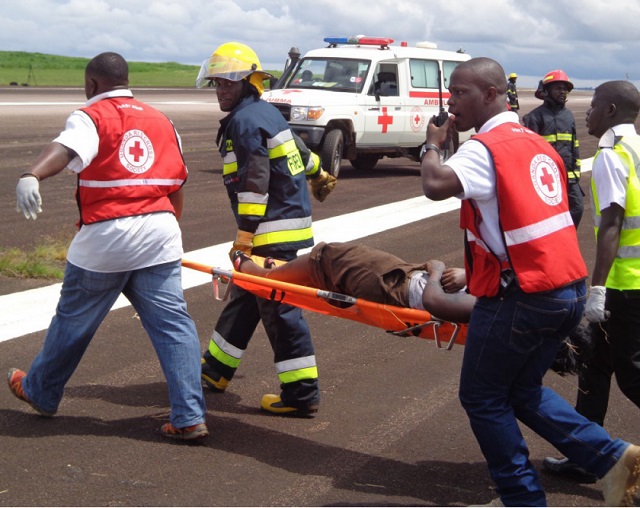
Many deaths could be prevented with the timely arrival of competent emergency pre-hospital medical services at accident scenes
| PATRICIA AKANKWATSA | When you enter the accident and emergency casualty ward at Mulago National Referral hospital, it is screams and grinding of teeth in pain, with doctors and nurses pacing up and down, attending to the patients. Then more patients are brought in. Some arrive by ambulance. But others arrive on motorcycles, the notorious police trucks, and other kinds of vehicles.
How these patients are ferried to the hospital is most striking. Arriving on any vehicle other than an ambulance; on police trucks or motorcycle, shows the victims have not had pre-hospital. The vehicles that deliver them do not have the needed equipment to provide pre-hospital care.
“Fewer than 5% of the victims arrive by ambulance,” says Dr. Olive Kobusingye an accident and emergency surgeon. And many of them arrive after the “golden hour”, that is the first hour after the injury has occurred, after which the severity of the injury escalates, she says.
That Uganda does not currently have a national formal pre-hospital care system is a growing concern.
While available data on outcomes in hospital emergency care may be limited, it is evident from the concerns and observations of various emergency unit personnel and the public that such a service is a vital necessity urgently needed to complement the emergency department efforts to save lives and prevent disability.
According to Maria Nkalubo, the principal operations in charge of emergencies at Ministry of Health, the Emergency Care system at scene is almost non-existent. There is also delayed detection and reporting of emergencies.
Nkalubo also says that the first responders at a road crash are not well trained in first aid and are ill-equipped to support crash victims.
“Pre-hospital care is given on a voluntary basis, by police, drivers, community people, and by bystanders near crash scenes in case of road traffic crashes, “she adds.
According to a survey carried out by the Makerere University school of public health on the state of EMS in Uganda 2020, it shows that the majority of trauma victims could be dying during the pre-hospital stage due to lack of EMS.
The survey shows that there is poor coordination of ambulance service providers, both public and private. Most public ambulances provide inter-facility services rather than support communities through crash scene pickups.
The private ambulance services are neither accredited nor do they have national standards to follow; therefore they determine the service that they provide.
There is also no set up system to harmonise the vehicle and driver registration data or a built capacity for data management on road safety.
When these incidences happen, they have direct impact on life of not only the survivors but also the entire family especially in cases of fatalities and serious injuries that may lead to sudden permanent disability.
“Many of these injury deaths could be prevented with the timely arrival of competent emergency pre-hospital medical services at the accident scene,” Kobusingye says.
“Timely emergency pre-hospital care to road traffic crash victims at the scene and subsequent transportation to the health facility may reduce the probability of injury severity and deaths,” she adds.
On average, 10 people die in road traffic crashes in Uganda, which is the highest in East Africa, according to police and the United Nations Economic Commission for Africa’s Road Safety Performance Review report for Uganda published in 2018. The World Health Organisation puts the annual fatalities to over 10,000 people.
Given the high road-crash rate in Uganda, Nkalubo says that the country requires a robust emergency care system to address the high road-injury burden. Unfortunately, post-crash care in Uganda is poor and under-developed.
“Although efforts are being made by the Government to set up a national ambulance service, the service has not yet been rolled out on the main road corridors, adding that, management of crash scenes is poor, as transport of victims is commonly provided by police personnel using trucks designed for other police duties,”
In addition, within the health sector, road injury prevention does not receive the appropriate attention it deserves considering the huge number of road crashes.
The Emergency Medical Services (EMS) survey 2018 by Ministry of Health found that there is no national lead agency to coordinate emergency medical services and that a toll-free number 912 allocated by Uganda Communications Commission has not been functionalised.
The survey also shows that there is ineffective emergency medical transportation and low distribution of ambulances with less than 25% population having effective ambulance coverage.
Many of the so-called ambulances also lack basic emergency care equipment and medicines. They, therefore, use the “Scoop and Run” ambulance approach.
Only 16% of districts have a designated office or agency responsible for EMS and only 13% of districts report any budget allocation specific for EMS.
The Uganda Hospital and Health Center IV Census Survey reports that capacity to offer emergency services at hospitals/ HC IVs is generally poor, with only 5% and 25% of the hospitals/HC IVs classified as having very good and good capacity respectively, according to 2014 figures.
EMS Survey 2018 also established that majority of EMS service provision 64% is funded by government and the rest by a combination of NGOs, Charity Organizations, Members of Parliament and Private companies.
The main service provider was police and the non-police service providers were for pay. There was a wide range of costs to patients ranging from Shs30, 000 to as high as Shs3.3 million for an ambulance transfer.
Uganda has no lead government agency to manage and coordinate pre-hospital care services. It has no clear policy and management plan for pre-hospital care providers and actors.
There are efforts to partner with communication companies through the Uganda Communication Commission to establish the three-digit number. This will be used to handle emergencies throughout the country and meet the best practice of a 3-digit telephone access number.
Kobusingye says that for hospital care to be effective, police officers and primary care providers must have good knowledge of the locations and levels of expertise of different hospitals in their regions.
****
 The Independent Uganda: You get the Truth we Pay the Price
The Independent Uganda: You get the Truth we Pay the Price


